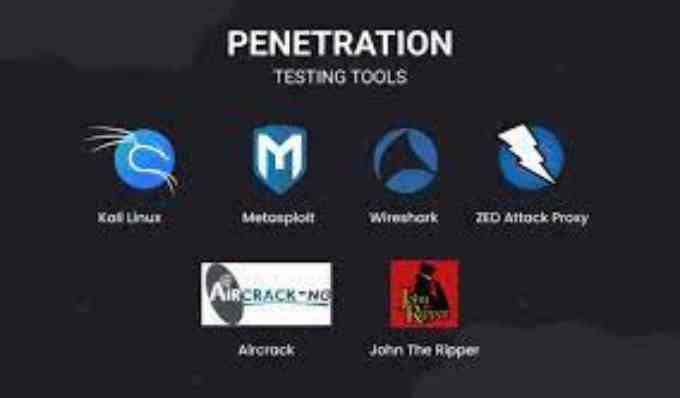Organizations often fall into the risk of running into malware or perilous attack from black hat hackers. This often leads to a loss of important data and a decrease in appliances and profit. In an attempt to prevent this from reoccurring, penetration testing tools are used to evaluate a computer system’s security for vulnerability. Penetration testing tools are widely used across different organizations and even individually. There are different types of penetration testing tools, but we will take open source/free and web application penetration testing tools. In this article, we evaluated top penetration testing tools that can be of help to you.
Penetration Testing Tools
Penetration testing (also known as a pen test), tools are used to automate penetrating operations, increase testing efficiency, and detect flaws that could be challenging to find using only human analytical techniques.
Types of Penetration Testing Tools
Penetration testing tools can be classified into various types including:
#1. Open-source Tools
These tools are created and maintained by developer communities from all over the world and are free to use. In every category, there are open-source solutions available.
#2. Web Application Penetration Testing Tool
Web application penetration testing tools are created especially for web apps. Typically, these are online tools that can test a web application by simply browsing the URL of the website. These tools predominate, with a manual pentest as a supplement.
#3. Network Penetration Tools
Network pen testing involves breaking into a network in the manner of a hacker to find security flaws. This includes a collection of tools created especially for identifying network vulnerabilities. For example, the network mapping tool NMap.
#4. App Penetration Testing
The scope and methodology of mobile app pentest are distinct from those of web app pentest. In the case of mobile apps, the need for human intervention is more critical. For testing mobile apps, there is no plug-and-play solution available.
#5. Cloud Penetration Testing
A cloud setup review is what we truly mean when we say “cloud pentest.” The conditions of your contract with your cloud provider control cloud security. There are some constraints you must operate within. You can get assistance from security professionals with tasks like testing your virtual machines, finding configuration errors in your cloud setup, and guaranteeing workload isolation.
Free Penetration Testing Tools
Penetration testing tools also include free tools that are available to anyone.
#1. Nmap
Network Mapper is referred to as NMAP. It aids in network mapping by scanning ports, locating operating systems, and compiling a list of hardware and the services it supports.
NMAP delivers differently constructed packets that return with IP addresses and other data for various transport layer protocols. This data can be used for security auditing, host discovery, OS fingerprinting, and service discovery.
NMAP enables security administrators to compile a list of all the hardware, software, and services linked to a network, allowing them to identify potential vulnerabilities.
#2. Metasploit
Hackers and security experts both utilize the Metasploit framework to find systematically weak points. It is a strong tool that incorporates elements of evasion, anti-forensic, and fuzzing technologies.
Metaspoilt is simple to install, compatible with many different platforms, and highly well-liked by hackers. It is also a valuable tool for pen-testers for this reason, in part.
Almost 1677 exploits and 500 payloads, including Command shell payloads, Dynamic payloads, Meterpreter payloads, and Static payloads, are now included in Metasploit.
#3. Wireshark
WireShark is used mostly for protocol analysis and minutely observing network activity. The fact that thousands of security engineers from all around the world collaborate to enhance it makes it one of the top network penetration test tools.
You can inspect protocols, capture and analyze network traffic, and troubleshoot network performance issues using WireShark. The decryption of protocols, as well as the capture of live data from Ethernet, LAN, USB, and other sources, are supplied as additional features.
Additionally, the output can be exported to XML, PostScript, CSV, or plain text. Wireshark is not an IDS, which is a crucial distinction to make. It can assist you in visualizing corrupted packets as a protocol analyzer, but it is unable to sound the alarm in the event of harmful activity on the network.
#4. Sn1per
Sn1per is a comprehensive penetration testing tool for researchers and security professionals. You can learn about the attack surface and vulnerabilities of your application using the ongoing Attack Surface Management (ASM) platform.
#5. Aircrack-ng
Aircrack-ng offers a whole range of network penetration testing tools for the evaluation of Wi-Fi network security. Since the tools are command lines, extensive scripting is possible. It is also a multi-platform that currently runs on Linux, Windows, macOs, FreeBSD, OpenBSD, and other operating systems.
#6. Commix
Commix is a free program that aids in identifying and exploiting vulnerabilities related to command injection. The tool automates the processes for vulnerability discovery and exploitation, improving speed, coverage, and effectiveness.
Commix, an efficient combination of a scanning tool and a command injection vulnerability exploiter, is short for Command and injection and exploiter.
#7. BeEF
Browser Exploitation Framework (BeEF) is a strong and efficient testing method that focuses on the web browser and its flaws. Unlike previous tools, it accesses and evaluates the target environment’s security posture via client-side attack vectors, in this case, web browser flaws.
The strategy enables the testers to enter and study the target’s internal environment without being detected by the perimeter protection that lies beneath it.
#8. HackTools
HackTools is a robust all-in-one browser extension that has a number of tools and cheat sheets for XSS payload testing, reverse shell testing, and other security-related tasks.
It typically appears as a pop-up or tab option. You may search for payloads on many websites and in your local storage with just one click after adding the extension.
#9. Modlishka
You can run an automatic HTTP reverse proxy with Modlishka. The tool can also be used to automatically poison the HTTP 301 browser cache. The app also allows you to take over non-TLS URLs. Typically, Modlishka can detect and expose 2FA flaws and supports the majority of multi-factor authentication methods.
#10. Dirsearch
Dirsearch is a tool for command-line web path scanning. You may brute force webserver directories and files using the feature-rich tool. In general, it allows administrators, security researchers, and developers to accurately study a variety of simple and sophisticated web material. The penetration testing tool offers excellent performance and cutting-edge brute force approaches with a wide range of wordlist vectors.
#11. Karkinos
This is a portable and effective penetration testing tool that enables character encoding and decoding, text and file encryption and decryption, as well as other security checks. In general, Karkinos is a collection of various modules that, when used together, let you run a variety of tests using a single tool. As a result, it has earned the moniker “Swiss Army Knife” for penetration testing. Karkinos can encrypt or decrypt characters in a number of common formats,
#12. Sifter
Sifter is a potent combination of numerous penetration testing tools. It includes a mix of vulnerability detection modules and OSINT and information collection technologies. The Sifter is a sophisticated penetration testing suite that incorporates a number of modules. It can swiftly search for vulnerabilities, carry out operations, enumerate local and remote hosts, examine firewalls, and more.
Web Application Penetration Testing Tools
Web-based programs can have security flaws that can be found using web application penetration testing. It employs a variety of attacks and penetration techniques with the goal of breaking into the web application itself.
A web application penetration test’s standard scope covers browsers, web-based apps, and their add-ons like ActiveX, Plugins, Silverlight, Scriptlets, and Applets.
These tests are regarded as being more complex because they are much more specific and focused. The endpoints of each web-based application that regularly interacts with the user must be found in order to conduct a successful test. From preparation to test execution and finally report compilation, this involves a substantial lot of time and work.
Here are the top web application penetration testing tool:
#1. John the ripper
John the ripper is a web application penetration testing tool. The tool iterates over all possible password combinations within a predetermined range of parameters when employing brute force to crack passwords. It can also work on different operating system including macOS, Windows, and Kerberos OS in addition to Unix-based operating systems.
#2. SQL map
SQLmap is another free web pen-testing tool that automates the process of identifying dangers and attacks related to SQL injections.
Among all web application pen-testing tools, SQLmap has a robust testing engine, supports a variety of servers, including MySQL, Microsoft Access, IBM DB2, and SQLite, and has many injection attacks.
#3. Zed Attack Proxy
Zed Attack Proxy also referred to as ZAP, is an OWASP-provided open-source penetration testing tool that may identify a number of vulnerabilities in online applications.
It can run penetration tests on online programs to find a variety of problems on Linux, Microsoft, and Mac systems.
ZAP, one of the top open-source pen-testing tools available, offers a wide range of pen-testing operations, which makes it the perfect tool for users.
#4. Burp Suite
With the aid of a well-rounded toolbox, Burp Suite, a penetration testing tool, enables you to strengthen your cyber security regulations. The tool has a wide range of functionality, including the Burp Repeater and Burp Intruder, which let you edit and manually reissue individual HTTP requests as well as automate tailored cyberattacks against your apps.
Burp Scanner also offers a passive scanning capability that lets you distinguish between active and passive checks during a check. You can then configure the goals and scopes and focus on regions that are simple to overlook. You may also run active scans with the tool to make sure your entire application is protected.
#5. Intruder
With the help of the cloud-based vulnerability testing tool and scanner known as Intruder, you can detect vulnerabilities in your online apps in addition to receiving feedback. By proactively monitoring for emerging risks and providing a threat prioritization solution, the technology reduces work time. The simplicity of Intruder’s security testing makes it possible for team members with less experience to conduct pen tests.
With Intruder, you can easily organize your activities and tests in an organized method thanks to its clear, simple-to-use, and thorough user interface. The user interface makes it simple to set up internal and external scans, create reports, and get feedback on what needs to be done to fix problems.
#6. W3af
The Web Application Attack and Audit Framework (W3AF) is a tool that is perfect for auditing and pentesting web applications. The framework can be extended using modules that were made to be simple to configure and grow.
By utilizing the Python API, the framework may be utilized both manually and automatically. The tool can spot about 200 distinct faults in web applications.
Easy expansion, cookie handling, and proxy support are important features. By providing recommendations, it improves any platform used for pen-testing.
#7. Core Impact
Core Impact is a thorough web application penetration testing tool that enables you to boost productivity by taking advantage of security flaws in your apps. The program offers a simple, clear user interface and the capacity to carry out quick penetration testing. it can uncover, test, and report information more effectively as a result.
You can adapt your pen tests across different systems, devices, and applications by using Core Impact’s functionality for reproducing multi-staged attacks. You can configure various tests and run them all at once using the capability. The ability to install an agent on the server through SMB and SSH is another feature of Core Impact that improves the efficacy of white box testing.
#8. Nessus
You can use the web application penetration testing tool Nessus to evaluate your online application’s vulnerabilities. Using the application, you may quickly find and address vulnerabilities such as malware, software problems, and missing updates. Nessus may function on a multitude of platforms and gadgets.
You can identify deeper vulnerabilities with Nessus’s ability to conduct credential and non-credential scans. By doing this, you can be certain that your application’s security flaws are being found and that you have complete test coverage. The program also includes coverage for network hardware like servers, endpoints, and virtualization systems.
#9. Gobuster
Gobuster is a penetration testing tool that can be accessed through GitHub. It enables you to scan your web application and brute force URIs, DNS subdomains, and Virtual Host names on target web servers to find vulnerable scripts and outdated configuration files
Gobuster is available on GitHub and may be set up through the console. With the help of the tool, you can run tests to explore the inner workings of your online application and find vulnerabilities. The program then gives a comprehensive report so you may efficiently review your code. Gobuster is fully open-source and free to use.
What Makes A Web Application Penetration Test Important?
Finding security flaws or vulnerabilities in web-based applications and their components, such as the database, source code, and back-end network, is a fundamental goal of web application penetration testing.
After identifying weaknesses or vulnerabilities, preventive measures are taken into account. Penetration testing tools are frequently used by corporate software companies to regularly test their programs. An incentive is given by Google and other tech behemoths for discovering and disclosing vulnerabilities in their application
Best Penetration Testing Tools
- AppTrana — Best fully managed web application firewall (WAF) solution
- Intruder — Provides a clear, detailed user interface making it easy for less experienced users to navigate
- Amass — Best for external asset discovery
- Invicti — Configure pre-set scan profiles for less experienced users
- Core Impact — Best for replicating multi-staged attacks
- Burp Suite — provides a passive scan feature
- Zed Attack Proxy (ZAP) — Focuses on being the “middleman proxy” between browser and application
- NMap — Lightweight solution to web application penetration testing
- Gobuster — Best for developers
- Nessus — Easy to use credential and non-credential scans
Criteria to Look Out for in Penetration Testing Tool
- User Interface (UI): Look for a clear, well-organized UI that is simple to utilize for any pen tester.
- Usability: When evaluating your web apps, look for features that provide comprehensive test coverage.
- Integrations: Search for tools that can be easily integrated with other penetration testing and project management software.
- Cost Effective: Search for tools with the most comprehensive functionality at the most affordable prices.
- Exploitation and detection: The tool must be able to find and exploit vulnerabilities.
- Results report: The tool must provide thorough results reports for all scans and tests that were run.
- Testing across different operating systems and devices is something the tool must support.
What Are the Top 5 Penetration Testing Techniques?
Penetration techniques are used in order to assess the network’s safety and security in a controlled manner. They include:
- OSSTM
- OWASP
- NIST
- PTES
- ISSAF.
What Are the Three 3 Types of Penetration Tests?
- White box penetration testing.
- Black box penetration testing.
- Grey box penetration testing.
What Are the 5 Stages of Penetration Testing?
#1. Reconnaissance and Planning
The first stage includes defining the test’s objectives and scope, as well as the systems it will test and the techniques it will employ. It will also include collecting information (such as network and domain names, mail servers, etc.) to learn more about a target’s operations and any potential weaknesses.
#2. Scanning
Knowing how the target application will react to different intrusion attempts is the next step. Usually, this is accomplished using:
- Static analysis: Analyzing the source code of a program to predict how it will function when it is executed. These tools have the ability to scan the entire code in a single pass.
- Dynamic analysis: Examining a running application’s code. This method of scanning is more useful because it offers a real-time window into an application’s operations.
#3. Gaining Access
This stage involves identifying a target’s weaknesses via web application assaults such as cross-site scripting, SQL injection, and backdoors. In order to comprehend the harm these vulnerabilities can do, testers then attempt to exploit them, often by elevating their privileges, stealing data, intercepting communications, etc.
#4. Maintaining Access
This stage’s objective is to determine whether the flaw can be used to establish a persistent presence in the system being exploited—long enough for a malicious actor to obtain in-depth access. The objective is to mimic advanced persistent threats, which frequently stay in a system for months in order to steal an organization’s most sensitive data.
#5. Review
The penetration test’s findings are then put into a report with the following information:
- Certain flaws that were exploited
- Access to private information
- How long it took for the pen tester to stay hidden in the system?
Security personnel examines this data to assist in configuring an enterprise’s WAF settings and other application security tools to fix vulnerabilities and defend against upcoming attacks.
How Is Penetration Testing Done?
Ethical hackers are used in pen testing to put themselves in the position of malicious actors. Network owners define a precise pen-testing scope that details which systems are subject to testing and how long the testing will last.
Setting scope establishes rules, a tone, and restrictions on what the testers are permitted to perform. Ethical hackers begin their work by searching for entry points to the network after setting a scope and timetable.
The tester can then try to get access to privileged accounts to delve farther into the network and access additional crucial systems after a system has been compromised. Pen-testers analyze a network and consider worst-case scenarios using escalation tactics.
What Are the Two Commonly Used Penetration Tests?
The two commonly used penetration tests include
- Standard Penetration Test (SPT)
- Becker Penetration Test (BPT)
- Cone Penetration Test (CPT).
Penetration testing is used to assess a material’s liquefaction potential as well as the strength of a foundation.
In Conclusion
A pen test can be carried out manually or automatically using security technologies. Penetration tests must reveal weaknesses that would give attackers access to the system so that the firm may improve its security practices and patch any vulnerabilities found. Penetration testing tools cannot be 100% perfect. Other preventive measures can taken into consideration.
FAQs
What skills are needed for penetration testing?
- Network and application security.
- Programming languages, especially for scripting (Python, BASH, Java, Ruby, Perl)
- Threat modelling.
- Linux, Windows, and MacOS environments.
- Security assessment tools.
- Pentest management platforms.
- Technical writing and documentation.
- Cryptography.
What are 3 disadvantages of penetration testing?
Penetration testing has several disadvantages including:
- Penetration tests may disrupt your business.
- Unintentionally reveal confidential information.
- Cost a lot of money.
- Tax your defense staff.
What is the most complicated penetration testing and why?
Web application penetration test.
Web application penetration tests are regarded as being more complex because they are much more specific and focused. The endpoints of each web-based application that regularly interacts with the user must be found in order to conduct a successful test.
- MARKET PENETRATION STRATEGY: A Guide to Market Penetration (+Free Tips)
- Market Penetration: Best 2023 Strategies & Definitive Examples (Updated)
- GROWTH STRATEGY FOR BUSINESS: Simple 2023 Tips & All You Need
- PENETRATION PRICING POLICY: HOW YOU CAN GAIN MARKET ENTRY
- Penetration Pricing Strategy: Guide for Emerging Markets
- PENETRATION TESTING: Definition, Tools, Companies & Salary






